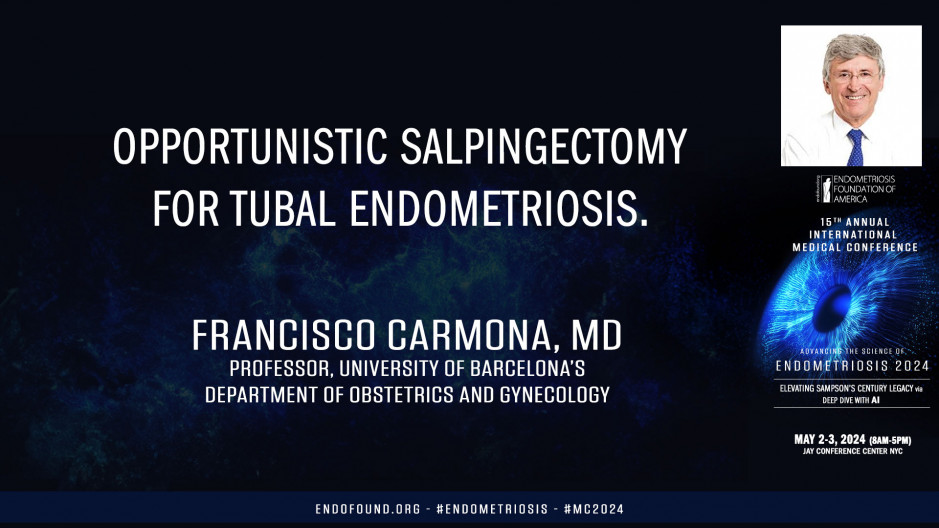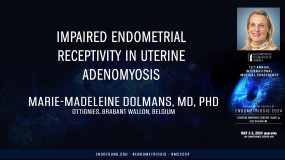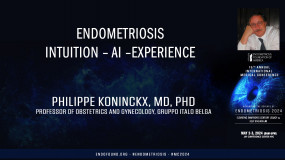International Medical Conference
Endometriosis 2024:
Elevating Sampson’s Century Legacy via
Deep Dive with AI
For the benefit of Endometriosis Foundation of America (EndoFound)
May 2-3, 2024 - JAY CENTER (Paris Room) - NYC
Thank you. Thank you Jacks for your presentation and thank you Dan and Tam for inviting me to be here. Today is a great honor. As Jack told before, my toll will be about theis are for two endometriosis. Then you have my disclosures and my geographies today will be to describe the incidents and what these two endometriosis and mainly the consequence of two endometriosis. We will discuss also the role of ovarian of the Ian tube endometriosis in the region of ovarian materials and ovarian cancer. And also to discuss that the pot potential effects of the sub opportunities ectomy in ovarian reserve and remain both. And also to analyze the benefits of a systematic incorporation of this technique. The ectomy in our daily practice that two is the involvement of the tubes in the no cases. Classically, you know that the incidence of endometriosis in the tube has been stated to be between four and 10% of the cases. But during the last four or five years there have been several papers focusing on this topic and those papers clearly shown that the real incidence of two random osis is much bigger than prior is suspected than perian described. You know that when you look at the microscopic disease, that the incidence can be as high as 40, even more percent of the cases of two random osis. And the consequences of this involvement of the tubes can have several phases. First for sure. Fertility is the main, is the main,
I don't know, I know the connection of this screen is something It's okay. No, that the skin is working.
I know, I know it's going back and
Forth. I'm not sure what it's, yeah, don't worry. So the fertility is the main problem for sure. The function of the tube can be affected by endometriosis. Even the cellular function of the tube can be affected by endometriosis, but not only fertility. Also pain can be an important problem in patients with two endometriosis. You know that all the inflammation, you know that there are several mechanisms of pain in patients with endometriosis. The local inflammation, neurosurgical inflammation, peripheral sensation, central citation, and other factors. A lot of factors may influence, can be the cause of the pain in patients with endometriosis, but we don't know which role may play exactly the involvement of the tubes in patients with endometriosis. And we need sure further studies to evaluate to have a proper evaluation of the role of the tube and the role of the ectomy in treating patients with the pain of patients with endometriosis.
We know also that the pure endometriosis has other implications. For example, this group coming from Arizona and from China, they clearly show that the possible relationship between two random osis and ovarian on ovarian endometriosis and also the possible relationship between tubal endometriosis and endometriosis related cancers in the ovary. Now we are at an important point in this tool that it is ovarian cancer, ovarian cancer, it's the first cause of death in women from genealogical malignancies. There are 20 20,000 new cases of cancer in the states, 2000 more than 2,500 in Spain every year. And the mortality is so high because we arrive today in a very advanced stages, frequently because there are no means of screening that there are two different types of ovarian cancer. Type one, type two, probably the type one related with endometriosis and can be we must keep is in mind.
But the type two that it is, the most frequent type of cancer in which the high grade sero carcinoma is clearly pertains this type and these related with the P 53 mutations. You know that the fallopian tube is so to be the origin of this cancer. The sick, the ERO tubal in cells may go into the body and be the origin as stated by 100 years ago by Samsung that we have already told this morning. But now we have scientific SE that this is the real origin of the cancer. You know, that all the research done in the last years from the 2000 about the region of cancer in patients with BRCA mutations being asked to the certainty that is in type two tumors and type two ovarian cancer is the sick or the sick are the origin. And it gives us the opportunity to change our paradigm that hysterectomy is one of the most frequent surgery performing in women.
A lot of times indication of ectomy is endometriosis and we are endometriosis surgeons and we have a responsibility on this field. And you know that maybe we have now the opportunity to make a significant risk reduction of ovarian cancer that probably will bring us to a new era in this disease. You know that there are no differences in if we perform the prothesis of the, in those patients, no differences in risk of surgical complications, not hospital admissions rates higher, the hospitalized the same and the surgery is not influenced by the ectomy. And we need to know, however, where is the impact of the ectomy of theis ovarian reserve in the ulcer of the menopause if it has a real impact on ovarian cancer mortality and the healthcare cost. And we can also ask if this procedure can be easily adopted by theologist and other specialists. You know that there are several studies looking at the effect of the ectomy in ovarian reserve in this paper publish some years ago. You can see that it was a randomized trial including patients for schedule at, for hysterectomy, for nine conditions, and then they perform anti hormones three months prior to the surgery in three months after. And you can see here how there were no differences in the level
In the letters of hormone. In any case, the same in this other, I don't know, but something happened.
There's something, this one. But in this paper again, they perform a prospective evaluation of the effect of hysterectomy in the now is the other one in the hormonal levels of the sing submitted to hysterectomy. And you can see exactly the same than before. There was not differences in not the three and nine months after surgery in patients regarding their hormonal levels. The same happens with the menopause. In this paper, I think it is a very interesting paper. It was a retrospective problem based study, a cohort study from Alia. You know that they have probably the biggest databases all over the world and they included more than 40,000 patients with previously performed hysterectomy, ectomy ectomy or ectomy plus ectomy. And when they look at in this moment, the patients go to the doctor to ask to referring menopausal symptoms. So asking for menopausal treatment. You can see here how the patients with opportunistic of ectomy has no differences with the patients with only ectomy showing that the problem is when you take out the ovaries for sure.
So if regarding the two, all the papers I have shown you, if the pros effect ovarian blood supply, it is not enough. It's no enough to result in no reserve munition or the alien of the menopause. And the most important thing is that we have the opportunity to reduce ovarian cancer. Ovarian cancer, which is one of the most later cancers for women in this study, which again was different study case from the study in Sweden. They include women with ovarian cancer tube pre cancer and then they include also obtain CONT case and look at that previous exposure to ectomy, atherectomy or tube ion. There will include more than 4,000 houses cases and more than 40,000, 45,000 cases. And look, the results are very clear that when you perform something to me, mainly that to me, although it said to me, may have a certain protein effect when you perform sarto, the number of cases with cancer is clearly, clearly lowered, especially the type two cancer that is the most serious one.
It is an interesting study coming from the states. It was just an study of calculation of the impact of ectomy in the mortality of ovarian cancer. The out, they know the rates of ectomy, the rates of tube allegation of ovarian cancer. And they try to the model to evaluate the cost effectiveness of the ProSal ectomy and the impact of this procedure in incidences of ovarian, of ovarian cancer, including the cost of renting any case of cancer and the number of life that can be saved. You can see here that the results are very clear that with the hysterectomy, the risk of ovarian cancer is a little bit smaller, but when you perform ectomy, the risk, the relative risk is decreased by to a 30%. And you can see here that the extra cost of performing the opposition is just $400. In the cases of when you were performing a tube obligation.
And when the scheduled surgery worse, hysterectomy, the cost is only 125, 20 $4. And taking in account, taking in mind that the providing council course is more than $65,000 at the first year then is almost $5,000 per year during the life of the women. And the last year when she's going to die, the cost is again 60,000, $64,000. That's last year. You can save almost $400 million per year. And the most important thing is you can save almost 2000 lives, 2000 new cases per year if you adopt this kind of policy. Proper mastectomy for sure. It can be easily adopted by these gynecologists in this study performed just very fast. Very soon after the paper by Coleman, you can see how most of the gynecologists in this country were performing.
60% of them were performing ectomy performing surgery for benign procedures. In conclusion, there is a role, a clear role of the fallopian tube in the development of ovarian cancer. And even the development of omes is a safe procedure that may decrease the risk of ovarian cancer and has no effect on any detrimental effect on beno, oppose or herself. And we should counsel our women about the opport potential for s performed by for this industrial meeting. There is no discussion, but we can discuss today. What about when we are performing surgery for endometriosis in patients with not more pregnancy aside, and we can try to discuss and for sure, we should try to convince our colleagues from other specialties, not only gynecologists, general surgeons, neurologists, when they bring to the OR a patient with no more reproductive desire to perform, not only for gynecological surgery, for all the surgeries, for all to perform, can be an opportunity to decrease the mortality of the ovarian cancer. And just to finish, to invite you to the next Congress of the SUD that will be in Prague in next April next year. Thank you very much for attention and sorry for all the technical inconvenience.










